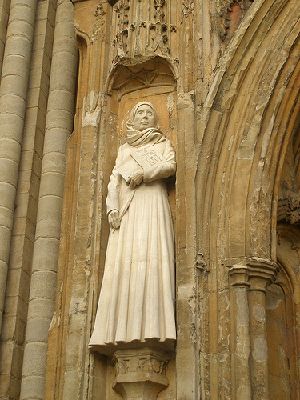Saint Julian of Norwich
| Julian of Norwich | |
|---|---|
| Born | November 8, 1342 |
| Died | c. 1416 |
| Venerated in | Roman Catholic Church, Anglican Communion, Evangelical Lutheran Church in America |
| Major shrine | Church of St Julian in Norwich |
| Feast | Roman Catholic Church, May 13 Anglican Communion and Evangelical Lutheran Church in America, May 8 |
Julian of Norwich (c. November 8, 1342 – c. 1416) is considered to be one of the greatest English mystics. Little is known of her life aside from her writings. Even her name is uncertain, the name "Julian" coming from the Church of St Julian in Norwich, where she occupied a cell adjoining the church as an anchoress. At the age of thirty, suffering from a severe illness and believing she was on her deathbed, Julian had a series of intense visions. (They ended by the time she overcame her illness on May 13, 1373.)[1] These visions would twenty years later be the source of her major work, called Sixteen Revelations of Divine Love (circa 1393). This is believed to be the first book written by a woman in the English language[2] Julian became well known throughout England as a spiritual authority: Margery Kempe mentions going to Norwich to speak with Julian[3].
Although she lived in a time of turmoil, Julian's theology was optimistic, speaking of God's love in terms of joy and compassion as opposed to law and duty. For Julian, suffering was not a punishment that God inflicted, but was a means he used to draw us closer to himself. This was different from the prevailing views of her time, which typically saw afflictions like the Plague as divine punishment. Because of her intimations that beyond the reality of hell-fire is yet a greater mystery of God's love, she has also been referred to in modern times as a proto-universalist.[citation needed]
Her great saying, "Sin is behovely, but all shall be well, and all shall be well, and all manner of things shall be well," reflects this theology. It is also one of the most individually famous lines in all of Catholic theological writing, and certainly one of the most well-known phrases of the literature of her era. It was quoted in T.S. Eliot's "Little Gidding," the fourth of his Four Quartets.
She is commemorated by the Roman Catholic Church on May 13, and by both the Evangelical Lutheran Church in America as a renewer of the Church and the Anglican Church on May 8.
A modern statue of her has been added to the facade of the Anglican Norwich Cathedral.
The song "Julian of Norwich" by Sydney Carter commemorates her optimistic philosophy.
Works
- Revelations of Divine Love
Notes
ReferencesISBN links support NWE through referral fees
- Abbott, Christopher. Julian of Norwich autobiography and theology. Woodbridge, Suffolk : D.S. Brewer, 1999. ISBN 9780585177564
- Baker, Denise Nowakowski. Julian of Norwich's Showings : from vision to book. Princeton, N.J. : Princeton University Press, 1994. ISBN 9780691036311
- Jantzen, Grace. Julian of Norwich : mystic and theologian.
New York : Paulist Press, 1988. ISBN 9780809129928
- Julian, and James Walsh, ed. Showings Edmund College; New York : Paulist Press, 1978. ISBN 9780809120918
- McEntire, Sandra J. Julian of Norwich : a book of essays. New York : Garland Pub., 1998. ISBN 9780815325291
- Magill, Kevin J. Julian of Norwich mystic or visionary? London ; New York : Routledge, 2006. ISBN 9780203008270
- Wilson, Katharina M. Medieval women writers. Athens, Ga. : Univ of Georgia Pr, 1984. ISBN 9780820306407
External links
Retrieved December 21, 2007.
- The Julian Site www.umilta.net
- Luminarium: Julian of Norwich, life, works, essays www.luminarium.org
- Revelations of Divine Love www.ccel.org
- Mother Julian of Norwich, selected prayers and poems www.poetseers.org
- Biographical sketch www.catholicforum.com
- Short appreciation www.saintpatrickdc.org
- Julian of Norwich www.biblicaluniversalist.com
- All is Well Audio CD / MP3 with readings from Revelations of Divine Love with original music. www.circleofexistence.com
- Julian of Norwich: presented by Gloriana's Court Extensive essay on Julian's spirituality, quotations from her writings with footnote explanations. www.gloriana.nu
Credits
New World Encyclopedia writers and editors rewrote and completed the Wikipedia article in accordance with New World Encyclopedia standards. This article abides by terms of the Creative Commons CC-by-sa 3.0 License (CC-by-sa), which may be used and disseminated with proper attribution. Credit is due under the terms of this license that can reference both the New World Encyclopedia contributors and the selfless volunteer contributors of the Wikimedia Foundation. To cite this article click here for a list of acceptable citing formats.The history of earlier contributions by wikipedians is accessible to researchers here:
The history of this article since it was imported to New World Encyclopedia:
Note: Some restrictions may apply to use of individual images which are separately licensed.


